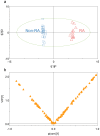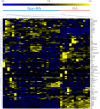Global metabolite profiling of synovial fluid for the specific diagnosis of rheumatoid arthritis from other inflammatory arthritis
- PMID: 24887281
- PMCID: PMC4041724
- DOI: 10.1371/journal.pone.0097501
Global metabolite profiling of synovial fluid for the specific diagnosis of rheumatoid arthritis from other inflammatory arthritis
Abstract
Currently, reliable biomarkers that can be used to distinguish rheumatoid arthritis (RA) from other inflammatory diseases are unavailable. To find possible distinctive metabolic patterns and biomarker candidates for RA, we performed global metabolite profiling of synovial fluid samples. Synovial fluid samples from 38 patients with RA, ankylosing spondylitis, Behçet's disease, and gout were analyzed by gas chromatography/time-of-flight mass spectrometry (GC/TOF MS). Orthogonal partial least-squares discriminant and hierarchical clustering analyses were performed for the discrimination of RA and non-RA groups. Variable importance for projection values were determined, and the Wilcoxon-Mann-Whitney test and the breakdown and one-way analysis of variance were conducted to identify potential biomarkers for RA. A total of 105 metabolites were identified from synovial fluid samples. The score plot of orthogonal partial least squares discriminant analysis showed significant discrimination between the RA and non-RA groups. The 20 metabolites, including citrulline, succinate, glutamine, octadecanol, isopalmitic acid, and glycerol, were identified as potential biomarkers for RA. These metabolites were found to be associated with the urea and TCA cycles as well as fatty acid and amino acid metabolism. The metabolomic analysis results demonstrated that global metabolite profiling by GC/TOF MS might be a useful tool for the effective diagnosis and further understanding of RA.
Conflict of interest statement
Figures




Similar articles
-
Metabolic discrimination of synovial fluid between rheumatoid arthritis and osteoarthritis using gas chromatography/time-of-flight mass spectrometry.Metabolomics. 2022 Jul 4;18(7):48. doi: 10.1007/s11306-022-01893-9. Metabolomics. 2022. PMID: 35781849
-
Application of global metabolomic profiling of synovial fluid for osteoarthritis biomarkers.Biochem Biophys Res Commun. 2018 May 5;499(2):182-188. doi: 10.1016/j.bbrc.2018.03.117. Epub 2018 Mar 24. Biochem Biophys Res Commun. 2018. PMID: 29551687 Free PMC article.
-
Variation in the synovial fluid metabolome according to disease activity of rheumatoid arthritis.Clin Exp Rheumatol. 2020 May-Jun;38(3):500-507. Epub 2019 Aug 27. Clin Exp Rheumatol. 2020. PMID: 31498072
-
Translational Metabolomics of Head Injury: Exploring Dysfunctional Cerebral Metabolism with Ex Vivo NMR Spectroscopy-Based Metabolite Quantification.In: Kobeissy FH, editor. Brain Neurotrauma: Molecular, Neuropsychological, and Rehabilitation Aspects. Boca Raton (FL): CRC Press/Taylor & Francis; 2015. Chapter 25. In: Kobeissy FH, editor. Brain Neurotrauma: Molecular, Neuropsychological, and Rehabilitation Aspects. Boca Raton (FL): CRC Press/Taylor & Francis; 2015. Chapter 25. PMID: 26269925 Free Books & Documents. Review.
-
Differential Metabolome in Rheumatoid Arthritis: a Brief Perspective.Curr Rheumatol Rep. 2021 Apr 28;23(6):42. doi: 10.1007/s11926-021-00989-w. Curr Rheumatol Rep. 2021. PMID: 33913028 Review.
Cited by
-
A specific diagnostic metabolome signature in adult IgA vasculitis.Metabolomics. 2024 May 24;20(3):61. doi: 10.1007/s11306-024-02107-0. Metabolomics. 2024. PMID: 38787468 Free PMC article.
-
Unveiling the Nexus: Cellular Metabolomics Unravels the Impact of Estrogen on Nicotinamide Metabolism in Mitigating Rheumatoid Arthritis Pathogenesis.Metabolites. 2024 Apr 11;14(4):214. doi: 10.3390/metabo14040214. Metabolites. 2024. PMID: 38668342 Free PMC article.
-
Reprogramming of tumor-associated macrophages by metabolites generated from tumor microenvironment.Anim Cells Syst (Seoul). 2024 Apr 3;28(1):123-136. doi: 10.1080/19768354.2024.2336249. eCollection 2024. Anim Cells Syst (Seoul). 2024. PMID: 38577621 Free PMC article. Review.
-
The protective effect of traditional Chinese medicine Jinteng Qingbi granules on rats with rheumatoid arthritis.Front Pharmacol. 2024 Mar 13;15:1327647. doi: 10.3389/fphar.2024.1327647. eCollection 2024. Front Pharmacol. 2024. PMID: 38545550 Free PMC article.
-
Global prevalence of persistent neuromuscular symptoms and the possible pathomechanisms in COVID-19 recovered individuals: A systematic review and meta-analysis.Narra J. 2021 Dec;1(3):e48. doi: 10.52225/narra.v1i3.48. Epub 2021 Dec 1. Narra J. 2021. PMID: 38450213 Free PMC article.
References
-
- Cammarata RJ, Rodnan GP, Fennell RH (1967) Serum anti-γ-globulin and antinuclear factors in the aged. JAMA-J Am Med Assoc 199: 455–458. - PubMed
-
- Litwin SD, Singer JM (1965) Studies of the incidence and significance of anti-gamma globulin factors in the aging. Arthritis Rheum 8: 538–550. - PubMed
-
- Rantapaa-Dahlqvist S, de Jong BAW, Berglin E, Hallmans G, Wadell G, et al. (2003) Antibodies against cyclic citrullinated peptide and IgA rheumatoid factor predict the development of rheumatoid arthritis. Arthritis Rheum 48: 2741–2749. - PubMed
-
- Humphreys JH, Symmons DP (2012) Postpublication validation of the 2010 American College of Rheumatology/European League Against Rheumatism classification criteria for rheumatoid arthritis: where do we stand? Curr Opin Rheumatol 25(2): 157–163. - PubMed
Publication types
MeSH terms
Substances
Grants and funding
LinkOut - more resources
Full Text Sources
Other Literature Sources
Medical
Research Materials
Miscellaneous

